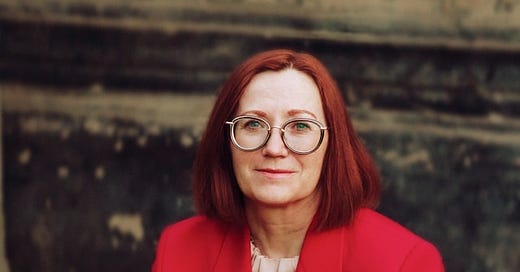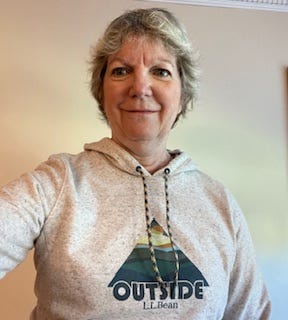I was 26 and working in New York in my first job after graduating from business school. Growing up in Denver, Colorado, my sense of style was very different from that around me.
Add to that the hustle and bustle of New York streets, and the pressure of seeming like I knew what I was doing as a newly minted MBA, and I am certain I looked lost and confused.
What did I do?
I went to Brooks Brothers and bought some very conservative-looking suits, so that I’d fit in. I thought, “Clothes make the man (or woman in this case).”
Mostly, my transition to New York professionalism was working. My hours were long. My colleagues and I often ate dinner in the office while we worked. I tried very hard to stay “within the lines” ( the ones you couldn’t see but you knew existed) so that I could conform to the world around me.
I was working in the consulting arm of an international public accounting firm, which added an extra dollop of conservatism to an already staid culture.
It was the mid-80s, and women had seldom made their way into the higher echelons of management. Except that in my second year of consulting, one did.
I was so proud to see a woman in the corner office. Katheryn was smart, attractive, walked with conviction, and said hi to us. What more could we want?
One day, she walked in wearing a red pantsuit. I thought it looked great. It was bold and spoke to a personal quality that I suspect allowed her to make her way up the ranks.
The red suit became the talk of the office. For sure, it became the lunch talk of my colleagues, but we later learned that it had become the talk of the firm’s partners as well.
They didn’t like it. It didn’t “fit” the image of the firm. After all, we were conservative. Conservative people don’t wear red, no matter how attractive and shapely the person is.
Katheryn only wore that suit once.
One year later, she left the firm.
I am not certain whether it was Katheryn’s story or just some random feedback where I connected the dots, but that year, I traveled with a firm’s partner to Korea for a two-week stint visiting Korean steel firms. (The word “conservative” does not do justice to these businesses.)
I had a full-length lavender puffy down coat that I brought with me.
Why not? It was cold in New York, and I wore it there most days. It would probably be cold in Korea, or at least, I didn’t want to get caught unprepared and shivering.
It was a fascinating trip. The year was 1986, and Korea was not used to women who were professionals. At each company we visited, the women were in the back, cutting fruit into beautiful shapes and serving us.
When we arrived at the first company, the Korean managers saw me and instantly arranged for a photographer to take a picture of me with the chairman. The group was both amused and curious by my presence.
The two weeks of travel with the partner went well. The work was done efficiently. Everyone got along. I was leaving Korea feeling victorious.
Except for the partner’s and my last moment in a chauffeur-driven ride back to the hotel. Mike was a mentor and had been a good friend to me. Probably because of this relationship, he felt fine telling me that my lavender coat “needed to go.”
“I love my coat,” I said. “It keeps me warm.”
I still remember Mike’s words.
“Yes, I understand that, Jill. But it doesn’t convey the image. You are smart and should be taken seriously. The coat does not help in this regard.”
When we returned to New York, I went straight to Brooks Brothers and bought a serious navy coat to wear during the week, and then wore my lavender coat on weekends.
I was angry, and I also thought Mike might be right.
And then I thought about Katheryn, who left the firm. Those were the dots I connected.
I lasted at the firm for another year, and I appreciated Mike’s guidance. I also decided that the firm’s culture was not for me.
Today, most of my wardrobe is from L.L. Bean. I wear jeans, sweatshirts (nice ones), colorful tees, and sneakers. I often have a dog by my side. In my self-defined culture, a lavender coat would have worked just fine. Instead, I have a L.L. Bean three-season parka that is pine green in color and waterproof.
From time to time, I think about Kathryn. It must have been very hard to be her — a woman in a corner office, who didn’t have colleagues to support her, and who liked the color red. She could carry it off, but chose not to.
I also continue to wonder whether that old adage, “Clothes make the man,” should be retired, and not because of gender, but sentiment.
I think I’d retire it. It’s true that positive appearances help us. When we look sharp (I leave it to the reader to decide what sharp is), we tell viewers, “I’ve got my act together.”
But there’s also that adage, “It’s what's inside that counts.”
So, which is it?
As I sit at my desk finishing off this piece and wearing an LL Bean sweatshirt, I think I’ve voted.
What say you?






My wife finally convinced me that clothes are important. They tell people who don't know us who we are, and what we think of ourselves. A while back I was going for a job interview. I knew people there wore business casual, so I was going to wear the same. After some warmly heated discussion with my wife and son (a company executive), I agreed to wear a suit and tie. I got the job. I'm sure the suit helped. A year or so later, I interviewed with the same manager for the same job, only this time it was a permanent position. I wore the same conservative navy blue suit. Again, I got the job. When I went through OTS some 50 years ago, they drilled into us the importance of looking sharp, which had precise definitions. Insignia, just so. Name tag, just so. Medals and ribbons, just so. Gig line - one straight line deviating not one millimeter at the belt buckle, which had to be shined to a mirror surface (shoes, too). You see the indoctrination worked as I remember it after all these years. The oft-repeated refrain "Look sharp. Feel sharp. Be sharp." still echoes in my mind. I don't know if clothes make the man (or woman), but they are certainly important. But, I'm with you on brands. I don't own any L.L.Bean, but wearing good quality, functional clothing makes a lot of sense to me. I enjoy my Patagonia vests and winter jacket.
Jill, this was such a thoughtful and relatable reflection. I found myself nodding the whole way through. So many of us have wrestled with the balance between fitting in and showing up as ourselves. Your story is a beautiful reminder that what we wear should reflect our worth, not define it.